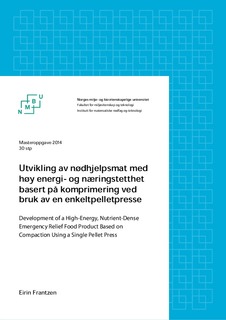| dc.description.abstract | The main objective of the research was to develop a nutrient-dense and high-energy emergency relief food product based on compression using a single pellet press (experiment 1). The recipe and the production process was developed based on specifications given for compact emergency relief food by IOM (2002). By measuring the physical properties of the tablets after processing, differences or similarities between tablets produced under different conditions were determined. The effect of compression pressure (4-338 MPa) and temperature (22, 35, and 50°C) on the tablets moisture content, water activity, density and tensile strength was studied (experiment 2a), and the effect of total moisture content in the recipe (6,2%, 9,6%, and 12,6%) and compression temperature (22, 35, and 50°C) on the end products moisture content, water activity, mass density, strength, water solubility and energy density was studied (experiment 2b).
The results in experiment 2a showed that the compression pressure did not have a significant effect (p>0.05) on the tablets moisture content or water activity, or on density and tensile strength when >105 MPa. The compression temperature had a significant effect (p < 0.05) on all response variables. The results in experiment 2b showed that the moisture content in the recipe and the compression temperature had a significant effect (p < 0.05) on all research variables. The tablets water content, water activity, mass density and tensile strength increased linearly with increasing compression pressure (R2 = 0,94-0,99). Tablets produced with 12.6% water content in the recipe and at 22 and 35°C had the best water solubility, and tablets produced with 9.6% water content in the recipe showed the highest tensile strength. It was observed an oil leakage under compression at 35 and 50°C and the energy density decreased linearly with increasing compression temperature. Compression at room temperature showed that the tablets mass density increased by reduced water content in the recipe. | nb_NO |

